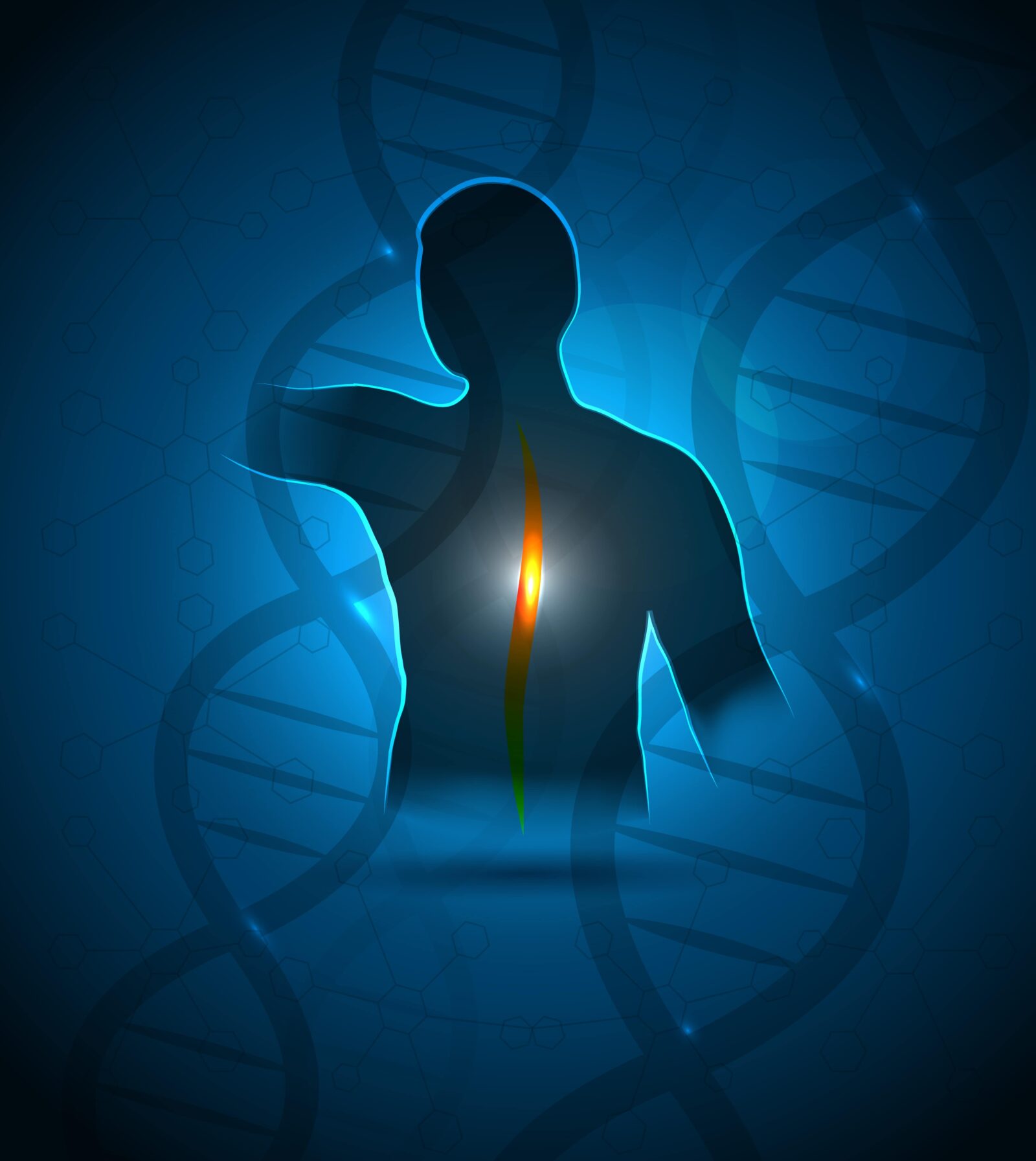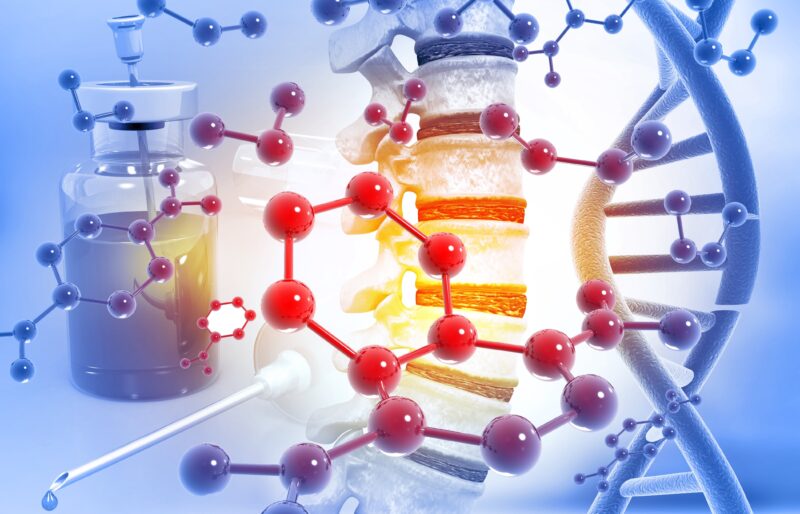Spinal conditions, ranging from mild discomfort to debilitating pain, affect millions of people worldwide. While factors like age, injury, and lifestyle play a significant role in the development of these conditions, recent research has shed light on the pivotal role genetics plays in determining spinal health. This article delves into the intricate relationship between our genes and the health of our spine.
Understanding Genes: The Blueprint of Life
At the most fundamental level, every living organism is governed by its genetic code. Genes are the smallest units of this code, acting as individual instructions for building and maintaining the body. They are segments of DNA (Deoxyribonucleic Acid) located on our chromosomes, and they carry the essential information required to produce proteins. Genes work in different ways such as:
- Transcription: The process begins with the transcription of a gene. During transcription, a segment of DNA is used as a template to synthesize a complementary RNA molecule. This RNA molecule, called messenger RNA (mRNA), carries the genetic information from the DNA to the cell’s protein-making machinery.
- Translation: Once the mRNA reaches the ribosomes, the cell’s protein factories, the process of translation begins. Here, the mRNA’s information is read and translated into a sequence of amino acids, which then fold into a functional protein.
- Expression: Not all genes are active at all times. Depending on various factors, including environmental cues, developmental stage, and cell type, certain genes are “expressed” or “turned on” while others remain “silent” or “turned off”. This selective expression ensures that cells function correctly and that the body can respond to changing conditions.
Genes and Spinal Conditions: The Connection
Spinal conditions can occur when something goes wrong with the genes. Here are a few ways that genes can lead to spinal conditions:
- Genetic Mutations: Sometimes, errors occur in the DNA sequence of a gene, leading to mutations. These mutations can result in the production of a malfunctioning protein or no protein at all. If the affected gene is involved in spinal health, this can lead to spinal conditions.
- Inherited Traits: Some spinal conditions have a hereditary component, meaning they can be passed down from one generation to the next. If a parent has a specific spinal condition due to a genetic mutation, there’s a chance their offspring might inherit the same condition.
- Gene Interactions: It’s not always a single gene that’s responsible for a condition. Sometimes, multiple genes interact in complex ways, increasing the susceptibility to spinal conditions. For instance, while one gene might make the spinal discs slightly weaker, another might affect bone density. Together, these genes could significantly increase the risk of conditions like Degenerative Disc Disease.
- Environmental Triggers: Genes don’t act in isolation. Environmental factors, such as physical trauma, diet, or exposure to certain chemicals, can influence how genes are expressed. In some cases, these factors can trigger the onset of spinal conditions in genetically predisposed individuals.
Genetic Predisposition to Spinal Conditions
Several spinal conditions have been linked to genetic predispositions. While the presence of specific genes can increase the risk of developing these conditions, it’s essential to understand that genes often interact with environmental and lifestyle factors. Here are some spinal conditions with known or suspected genetic components:

Degenerative Disc Disease (DDD):
This condition involves the breakdown of the intervertebral discs, which act as cushions between the vertebrae. Some studies have identified specific genes associated with an increased risk of DDD.
Scoliosis:
Scoliosis is characterized by an abnormal curvature of the spine. While the exact cause of scoliosis is often unknown, there’s evidence suggesting a genetic component, especially in cases where multiple family members are affected.
Spinal Stenosis:
This condition involves the narrowing of the spaces within the spine, which can put pressure on the nerves. Genetic factors can influence the size of the spinal canal, making some individuals more susceptible.
Ankylosing Spondylitis:
This is a type of inflammatory arthritis that primarily affects the spine. It can lead to the fusion of vertebrae, causing a rigid spine. There’s a strong genetic component to this condition, with the HLA-B27 gene being a known risk factor.
Osteoporosis:
While not exclusively a spinal condition, osteoporosis can lead to vertebral fractures due to decreased bone density. There are known genetic factors that influence bone density and the risk of developing osteoporosis.
Spina Bifida:
This is a neural tube defect where the spine and spinal cord don’t form properly. There’s evidence to suggest that genetic factors, in combination with environmental factors, play a role in its occurrence.
It’s important to note that while genetics can increase the risk of developing these conditions, they don’t guarantee their onset. Lifestyle factors, environmental exposures, and other variables can also play significant roles in the development and progression of spinal conditions.
How to Decrease the Risk of Spinal Conditions
If someone has a genetic predisposition to a spinal condition, it can understandably be a source of concern. However, having a genetic predisposition doesn’t guarantee the onset of the condition; it merely increases the risk. Here are some proactive steps individuals can take if they know or suspect they have a genetic predisposition to a spinal condition:
Regular Medical Check-ups:
Regular visits to a physician, especially one specializing in orthopedics or rheumatology, can help monitor for early signs of spinal conditions. Early detection often leads to better outcomes.
Maintain a Healthy Lifestyle:
- Diet: Consuming a balanced diet rich in calcium and vitamin D can support bone health.
- Exercise: Regular physical activity, especially weight-bearing exercises, can strengthen the muscles supporting the spine and improve bone density. However, it’s essential to choose exercises that are safe and appropriate for one’s condition.
- Avoid Smoking: Smoking can reduce bone density and impair blood flow, exacerbating spinal conditions.
Practice Good Posture:
Maintaining proper posture, whether sitting, standing, or sleeping, can reduce strain on the spine and decrease the risk of developing or worsening spinal conditions.
Ergonomic Workspaces:
Ensure that workspaces, especially if working long hours at a desk, are ergonomically designed to reduce strain on the back and neck.
Limit Heavy Lifting:
If lifting is necessary, use proper techniques by bending at the knees and keeping the back straight. Consider using supportive equipment or seeking help when lifting heavy objects.
Consider Physical Therapy:
A physical therapist can provide exercises and techniques to strengthen the back muscles, improve flexibility, and reduce pain.
Medications:
Some conditions, like osteoporosis or ankylosing spondylitis, may benefit from specific medications that can prevent progression or alleviate symptoms.
Join Support Groups:
Connecting with others who have similar concerns or conditions can provide emotional support, share experiences, and offer practical advice.
Overall, while a genetic predisposition can increase the risk of a spinal condition, proactive measures can significantly reduce this risk or manage the condition effectively if it develops. It’s essential to work closely with healthcare professionals and stay informed to make the best decisions for one’s health.
In Conclusion
While genetics play a crucial role in spinal health, it’s just one piece of the puzzle. Environmental factors, lifestyle choices, and preventive care are equally important. However, as we continue to unravel the mysteries of our genes, we move closer to a future where spinal conditions can be predicted, prevented, and more effectively treated.










